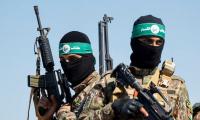The US Congress has recently put a spanner in the sale of F16s to Pakistan on concessional rates. Aid and geopolitics has apparently again started interacting to the detriment of the future Pakistan-US relations at a crucial juncture of Afghan peace parleys.
Geopolitics has been influencing the humanitarian and development aid disbursement strategies ever since the end of the World War II and the establishment of global institutions, like the UN and the two Bretton Woods sisters, ie the IMF and the World Bank. Humanitarian aid and development was initially projected as a noblesse oblige reconstruction endeavour, during the state-building and stabilisation stage of post-war Europe and Africa, and later during the cold war as a conflictual concomitant of the neo-colonial struggle for global domination.
After the World War, the strategy manifested itself in the form of post-war reconstruction and state-building in countries like Japan and Germany. In order to consolidate its political and economic leadership, the US started the Marshall Plan, a generous reconstruction and state-building enterprise that helped a war-devastated Europe stand on its feet to confront the rising menace of communism, and also get integrated into the Bretton Woods-defined global economic system. It was a political imperative to provide military cover through the North Atlantic Treaty Organization (Nato) and an economic necessity to help devastated European economies stand on their own feet.
During the cold war and in the seventies, the ‘development aid’ given to countries throughout the world was used as leverage to contain communism. There was competition between the two super powers to capture markets as well as extend their influence globally. Generous development aid was doled out to countries, including Pakistan, which was tied to the political bonds between the US/West and the aid recipient countries. The dissolution of the USSR and the end of the cold war led to Francis Fukuyama’s famous “end of war” thesis, which the Bretton Woods institutions latched on to by espousing the infallibility of marketisation and democratisation.
The Washington Consensus was forged in the US, wherein a universal prescription of the economic and political liberalisation of the controlled economies was envisaged as a neo-imperial project, dressed in the altruistic hues of helping developing nations. The Structural Adjustment Plan (SAP) was the economic credo of the new economic panacea for the developing economies, which called for macroeconomic stability, the reduction of fiscal deficits, liberalisation and the deregulation of economies. This universal prescription imposed social costs that engendering income inequalities and failed in nearly all development interventions in the nineties. The examples of Angola, Rwanda, Mozambique and Bosnia attest to the restrictive nature of the economic regime under SAP.
The criticism of SAP and the income inequalities and poverty engendered by the Washington Consensus resulted in some rethinking, and the global north, headed by the US and the UN, came up with the Millennium Development Goals to improve the human security index, including indices for health, education, gender support and social reforms. Poverty reduction was the new face of the development aid disbursement after SAP. The geopolitical imperative now was a new virulent threat of radicalisation and terrorism that, in Duffield’s words, threatened the peace and order of the stable Western democracies, and they framed the development discourse in terms of a security framework.
Underdevelopment was therefore securitised as a threat against Western interests, and aid disbursement strategies were accordingly planned as poverty reduction to mitigate the unrest in unstable societies.
The next variant in the development aid strategy was the ‘livelihood development’ approach, aimed at development interventions to empower local communities for sustainable peace. Both poverty reduction and livelihood revival have been employed in Pakistan, especially in the north-western part, but the enterprise was compromised by the lack of involvement of government agencies and the overt reliance of the UN on NGOs and INGOs, which resulted in inefficient resource allocation.
The US aid disbursement, seen in the context of a US-Pakistan expedient alliance, was therefore a time-bound and specific aims-based arrangement, which was sooner or later supposed to unravel. The US was supposed to have climbed a little further up on the learning curve with the hindsight knowledge of the mess that it left behind after its precipitous withdrawal from Afghanistan in the late eighties. The conflation of the Indo-Pakistan conflict with the counter-terrorism aid, under the influence of some parochial lobbyists in Washington, neither redounds to the US’s credibility as a reliable anti-terror coalition partner, nor to the efficacy of a puissant counter-terror strategy in Afghanistan.
Pakistan needs the high performance aircrafts for precision strikes against the terrorists holed up in the forested mountain fastnesses of one of the most difficult terrains in the world. The F16s, if delivered, would most certainly decimate the marauding capability of the terrorists. The US Congress’ decision, influenced by lobbyists with blinkered vision, threatens to undo the US commitment to counter-terrorism and to lay the basis for long-term stability, founded on aid for development.
At this crucial juncture, the US has to show vision and courage to upend Duffield’s neo-Monroe development paradigm, which related aid to the selfish interests of West. The US aid to Pakistan, therefore, has to transcend the counter-brushfire stage to a stability inducing stage, in the interest of both countries as well as regional security.
The writer is a PhD scholar at Nust.
Email: rwjanj@hotmail.com
A view of the Supreme Court of Pakistan. — Supreme Court website/FileWhat kind of firewall does the judiciary...
Indian soldiers stand alongside a barbed wire on the Line of Control. — AFP/FileAnti-Pakistan propaganda remains a...
A representational image showing farmers harvesting wheat crops in a field. — AFP/FileThere is a clear, lasting, and...
Pakistan's first president Major General Iskander Mirza while speaking with the Turkish Prime Minister Adnan...
Prime Minister Shehbaz Sharif pictured alongside President Asif Ali Zardari. — INP/FileBeing a man of action in...
A worker fixes a flag of the ruling Bharatiya Janata Party on a hoarding of their leader and India’s Prime Minister...







